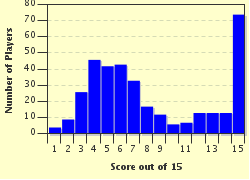Quiz Answer Key and Fun Facts
1. What can be seen on the roof of a house on the left of "Netherlandish Proverbs" (ca.1559) by Pieter Bruegel the Elder?
2. What is sitting on the drunken woman's shoulder in Frans Hals's "Malle Babbe" (ca.1635)?
3. What is odd about the way Earl Squanderfield (seated on the right) is sitting in Hogarth's "The Marriage Settlement" (ca.1743), first in the "Marriage à-la-mode" series?
4. What is the baby Jesus holding in Jan van Eyck's "The Madonna with Canon van der Paele",(ca.1436), housed in Bruges?
5. Rembrandt's "The Shooting Company of Frans Banning Cocq" (1642), commonly known as "The Night Watch", is surely one of the most well-known paintings in the world. If you look closely at the little girl, what has she got hanging from her belt?
6. What kind of exotic animal was Clara, who was portrayed by various artists, most famously by Venetian painter Pietro Longhi, in 1751?
7. What can be seen on the walls of Vermeer's paintings "Soldier And Laughing Girl"(ca.1658) and "The Art Of Painting"(ca.1670), amongst others?
8. What can be seen in Marat's right hand in "The Death of Marat" by Jacques-Louis David?
9. How is the woman cooking the eggs in "The Old Woman Cooking Eggs" by Diego Velázquez?
10. Hieronymus Bosch is well-known for painting people and animals in strange attire and positions. In "The Stone Operation"(ca. 1494), which is likely a copy of the original, what is the surgeon wearing on his head?
11. What gruesome deed is being carried out in Caravaggio's "Judith And Holophernes", dated 1599?
12. What, or who, is next to the open door in the further room in Pieter de Hooch's "The Mother" (1670)?
13. What is Emperor Maximilian holding in his hand in Albrecht Dürer's "The Portrait of Emperor Maximilian I" (1519)?
14. In the Groeningemuseum, Bruges, you can see two paintings by Gerard David. The left panel shows the "The Judgment of Cambyses" . Next to it Sisamnes' punishment is depicted. What punishment is being meted out?
15. What domestic animal is seen in Jean-Baptiste-Siméon Chardin's 1728 painting "The Skate", housed in the Louvre?
Source: Author
thula2
This quiz was reviewed by FunTrivia editor
looney_tunes before going online.
Any errors found in FunTrivia content are routinely corrected through our feedback system.

